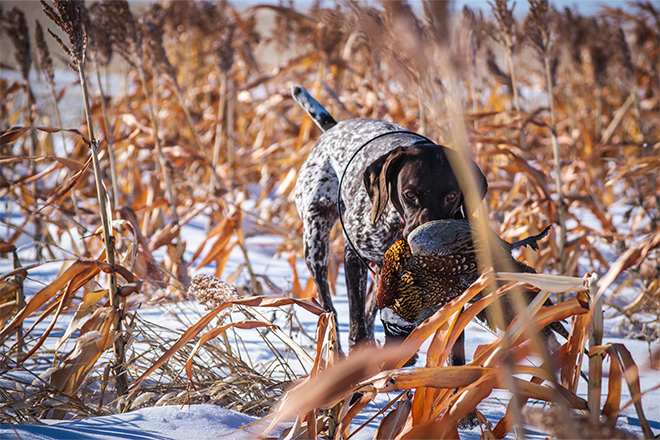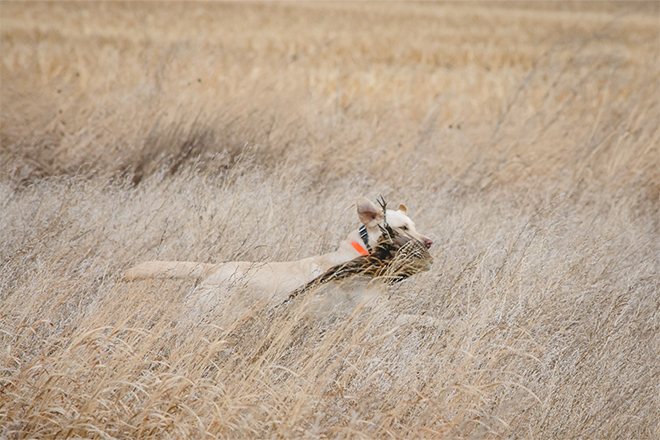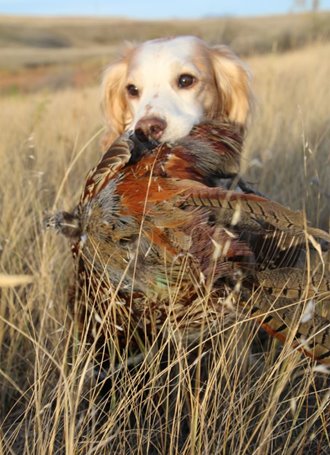How to help your dog hunt down and dig up more crippled, running and sailed birds
Story By Anthony Hauck, Photos by Marissa Jensen
The east and south lines of the quarter section of grassland run along corn stubble, coming to
the brushy, overgrown point of an old rockpile. You’d bet the farm it’s the kind of spot where
there just has to be a rooster.
And there is.
As the frenzied spaniel and I close in, my mind’s eye sees a cornered rooster with nowhere to go but up. The spaniel nips at his spurs as he explodes vertically. Then he quarters away over the open field. All that’s left after the trap-range shot is for the cocker to clean up, a retrieve so easy it’s routine.
But roosters and routine are two words that rarely pair.
Instead of getting boxed in, the bird breaches the line, craftily punching our narrow gap and slipping out the back door. The reversal gives way to a running rise, and a low liftoff partially obstructed by a lone, and now annoying, volunteer tree.
The shot connects but only a wing flags and the rooster hits the ground in the worst possible way: heart pounding and with two good legs.
This was a heap of trouble.
Tough Birds
Hunt pheasants with any regularity and you’ll find yourself a frequent visitor to this Land of Trouble, an inhospitable place where seconds turn into minutes, stomachs sink, and trails go cold — the place where downed birds go to lost birds.
The bobwhite quail may indeed be a gentleman. Go ahead and crown the ruffed grouse the King of Gamebirds. But don’t put the rooster ring-necked pheasant in that group. He’s not just punching in a different weight class, he’s playing a completely different sport — his version of mixed martial arts compared to the other birds’ gloved sparring.
Like a cage fighter, a rooster pheasant possesses that part detestable, part admirable habit of, despite blood and broken bones, being incorrigible to his mortality. The still-live bird puts this together by sailing as far as wings will fly, running as far as legs will carry, and burrowing as deep as possible for cover to conceal. Frighteningly, it’s often a combination of the three.

Visiting this Land of Trouble happens to all of us. But you and your dog can come out the other side with bird in hand.
Here’s how to train for trouble.
Investment Strategy
Guy Billups IV left the world of finance to open Wildrose Kennels. Now he brings the same
philosophy to developing a four-legged pheasant finder that he did to managing a successful
portfolio: He’s looking at a long-term investment.
Billups, who also serves as Purina ambassador, says the biggest hedge needs to be, no matter the breed, a well-bred puppy from proven hunting lines. With such a pup, any eager owner wants the instant gratification of early returns. But creating a dog capable of tracking a country mile is more like growing a savings account.
“You slowly develop this trait and form a bond in the field with your dog,” says Billups. “One yard becomes five, becomes 10, then 20 and so on. You can expect to see improvement, but you shouldn’t expect this to happen in a couple months. Think more like years.”
Training Grounds
“Most dogs are pretty wired to follow a track,” says Tony Roettger, owner of Roettger Ridge
Kennels in Ham Lake, Minnesota, and trainer and breeder of field English cockers and springers.
Roettger likes to pour gasoline on this instinctual fire by training dogs to track with clipped wing
birds — birds with their primary wing feathers clipped to prevent flight.
Clipped wing birds still have legs and half a wit, meaning they’ll wander, walk and run,
establishing scent trails for your dog to track.
Roettger’s trouble bird training scenario setup goes like this: Have a training partner take a clipped wing bird out to a distance and toss the bird, allowing your dog to make a mark. Wait a minute, so the bird will move away from that spot, and then send pup on the way.
Urban Training
Roettger lives in the Twin Cities metropolitan area, so he knows a thing or two about training
bird dogs in the Big City. In fact, he wrote the book on it, having co-authored Urban Gundogs:
Training Flushing Dogs for Home and Field.
To keep pup’s nose working trails, Roettger keeps a very simple strategy in his training regimen:
Drop a tennis ball in a bag of feathers or dab a little liquid bird training scent (there are many
varieties) on it, then toss it with a tennis ball launcher. Even tennis balls vanish in park grass, but if it happens to roll into a brushier or thicker edge, even better. The key is to make the ball “disappear.”
It only sounds pedestrian until you realize by doing so, your dog has to make a sense switch,
relying on nose rather than eyes. Break down the basic elements — a long scent trail and an
object buried in a tuft of grass — and your “ball dog” will be a bird dog when pheasant season rolls around.
Pup Can Figure It Out
Whether it’s a tennis ball tucked in cover or a dummy under a downed log, Roettger urges
trainers to resist the natural urge to intervene during sessions.
“The more you stay quiet and let dogs trust their instincts, the better they’ll be long term,” he says. “When you start trying to help them, the more they ask for. And you don’t want a dog asking you where the rooster is.”

There will come a point when searching for a wild, downed rooster that will test the minute hand on your watch. Roettger says if it takes your dog 15 minutes to make one training retrieve, so be it: “If it was one good retrieve, that’s worth it. That’s a great training session.”
Hunting Grounds
When Roettger heads for the hunting grounds, he alters tactics.
“I still give the dog the opportunity to find it, but instead of standing back 20 or 30 yards, I’ll go up to the mark to see if I can spot feathers or any blood. This may be of assistance and cut time if the dog is heading north but I have to redirect him south.”
How should a handler know when to step in? Welcome to hunting’s humanities section, unequal parts art, science and gut feel.
Billups, Roettger and most dog trainers refer to this as “reading a dog,” an interpretation of its body language and emotion. “You have to make that determination of whether the dog is on the track, or if you have to pull them back in and try again,” says Roettger. “It’s just super specific and super personal, based on the relationship you have with that dog.”
If you gamble and come up snake eyes, Billups resorts to his familiar money play: patience. “When a bird is on the ground, you have to make every effort possible to pick it up,” he says. “Sometimes that just means having the patience to regroup with your dog, fight your own urge to move on, and hold that ground for as long as it takes to find that bird.”
Saved Again
Upon the mark, the spaniel immediately picks up the track. The time it takes her to straight-line 100 yards is the time it takes me to hang my blaze orange hat on a sapling to mark the spot. At least I feel useful.

Standing pat, I catch a glimpse of her zigzagging the hillside across the depression. The rooster
is in a last gasp to shake her, but I’ve read her, and know this is her kick.
I grab my hat from the branch. Fitting it on, I see the spaniel working her way back across the
low plain, and she’s carrying three pounds of angry rooster.
Once again, we’re almost out of trouble.
Anthony Hauck has a trio of English cocker spaniels to bail him out. A regular Pheasants
Forever contributor, he and his dogs live in Saint Paul, Minnesota. Final photo is credit the author.
This story originally appeared in the Summer 2021 Issue of Pheasants Forever Journal
.